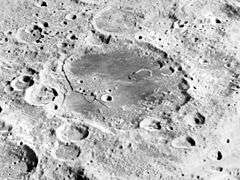Jules Verne (crater)
|
Oblique Lunar Orbiter 2 image, facing south | |
| Coordinates | 35°00′S 147°00′E / 35.0°S 147.0°ECoordinates: 35°00′S 147°00′E / 35.0°S 147.0°E |
|---|---|
| Diameter | 143 km |
| Depth | Unknown |
| Colongitude | 215° at sunrise |
| Eponym | Jules Verne |
Jules Verne is a large lunar crater on the far side of the Moon, named after the French author. It is located to the west-southwest of the Mare Ingenii, one of the few lunar mares on the far side. To the southeast of Jules Verne is the crater Lundmark, while Koch is located to the south-southeast. To the northwest is the large walled plain Pavlov.
Most of the interior floor of this crater has been flooded with basaltic lava, leaving a dark, low-albedo surface that is relatively level and flat. It is somewhat unusual for a crater feature on the far side to be flooded with lava, as the crust is generally thicker than on the near side. However this crater is located entirely within the South Pole-Aitken basin.
The outer rim of Jules Verne is worn and eroded, with several craters lying across the edge. Along the eastern edge lies Jules Verne G, while Jules Verne C penetrates the northeastern rim and Jules Verne Z cuts across the northern rim. A small crater also lies across the southern rim, while Jules Verne P is attached to the exterior along the south-southwest.
Jules Verne is one of the few lunar craters that is known by a person's full name rather than the surname. It is also named for a science-fiction author rather than a noted scientist or explorer, as is typical. (But see H. G. Wells.)
Satellite craters
By convention these features are identified on lunar maps by placing the letter on the side of the crater midpoint that is closest to Jules Verne.
| Jules Verne | Latitude | Longitude | Diameter |
|---|---|---|---|
| C | 33.2° S | 149.7° E | 30 km |
| G | 35.1° S | 150.0° E | 42 km |
| P | 38.0° S | 145.1° E | 62 km |
| R | 36.9° S | 140.9° E | 49 km |
| X | 32.1° S | 145.2° E | 15 km |
| Y | 31.3° S | 146.0° E | 30 km |
| Z | 32.5° S | 146.8° E | 20 km |
References
- Andersson, L. E.; Whitaker, E. A. (1982). NASA Catalogue of Lunar Nomenclature. NASA RP-1097.
- Blue, Jennifer (July 25, 2007). "Gazetteer of Planetary Nomenclature". USGS. Retrieved 2007-08-05.
- Bussey, B.; Spudis, P. (2004). The Clementine Atlas of the Moon. New York: Cambridge University Press. ISBN 978-0-521-81528-4.
- Cocks, Elijah E.; Cocks, Josiah C. (1995). Who's Who on the Moon: A Biographical Dictionary of Lunar Nomenclature. Tudor Publishers. ISBN 978-0-936389-27-1.
- McDowell, Jonathan (July 15, 2007). "Lunar Nomenclature". Jonathan's Space Report. Retrieved 2007-10-24.
- Menzel, D. H.; Minnaert, M.; Levin, B.; Dollfus, A.; Bell, B. (1971). "Report on Lunar Nomenclature by the Working Group of Commission 17 of the IAU". Space Science Reviews. 12 (2): 136–186. Bibcode:1971SSRv...12..136M. doi:10.1007/BF00171763.
- Moore, Patrick (2001). On the Moon. Sterling Publishing Co. ISBN 978-0-304-35469-6.
- Price, Fred W. (1988). The Moon Observer's Handbook. Cambridge University Press. ISBN 978-0-521-33500-3.
- Rükl, Antonín (1990). Atlas of the Moon. Kalmbach Books. ISBN 978-0-913135-17-4.
- Webb, Rev. T. W. (1962). Celestial Objects for Common Telescopes (6th revised ed.). Dover. ISBN 978-0-486-20917-3.
- Whitaker, Ewen A. (1999). Mapping and Naming the Moon. Cambridge University Press. ISBN 978-0-521-62248-6.
- Wlasuk, Peter T. (2000). Observing the Moon. Springer. ISBN 978-1-85233-193-1.
